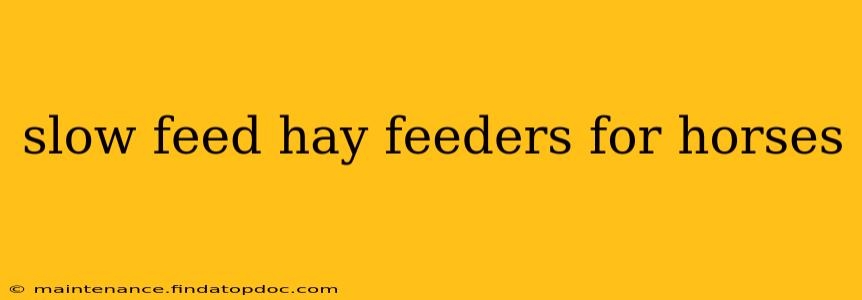Keeping your horse healthy and happy involves more than just providing adequate nutrition; it's also about how you deliver that nutrition. For horses prone to weight gain, digestive issues, or simply those who bolt their food, a slow feed hay feeder can be a game-changer. These innovative feeders are designed to encourage slower, more natural grazing, mimicking the horse's natural foraging behavior. This article will delve into the benefits, types, and considerations when choosing a slow feed hay feeder for your equine companion.
What are the Benefits of Slow Feed Hay Feeders?
Slow feed hay feeders offer a multitude of benefits for horses of all breeds and disciplines. These advantages extend beyond simply slowing down eating speed:
- Improved Digestion: Slower eating reduces the risk of colic and other digestive upsets caused by consuming large quantities of hay quickly. This is particularly crucial for horses prone to gastric ulcers.
- Weight Management: By extending feeding time, slow feeders help horses eat at a more controlled pace, preventing overconsumption and promoting healthy weight maintenance. This is ideal for overweight or obese horses.
- Dental Health: The design of slow feeders often encourages chewing, which helps maintain dental health and prevent dental problems associated with rapid eating.
- Reduced Boredom and Stress: The challenge of extracting hay from the feeder provides mental stimulation, reducing boredom and stress, which can be particularly beneficial for stabled horses.
- Manure Management: Slower eating often leads to better digestion and smaller, drier manure piles, resulting in easier and more efficient manure management.
What are the Different Types of Slow Feed Hay Feeders?
The market offers a wide variety of slow feed hay feeders, each with its own unique design and features. Choosing the right one depends on your horse's individual needs and your budget:
- Net Feeders: These are among the most popular types, often made of durable, strong nylon or heavy-duty plastic mesh. They're relatively inexpensive and easy to clean. However, horses can sometimes be more successful at ripping through them than others, making them more suited to certain horses.
- Slow Feed Hay Bags: Similar to net feeders, these bags often have smaller holes to further restrict the flow of hay. They are often portable and easy to hang, ideal for use in fields or smaller stables.
- Puzzle Feeders: These feeders incorporate intricate designs, requiring horses to work for their food, providing a greater mental challenge and slowing down eating even further. They are commonly more expensive.
- Floor Feeders: These feeders sit on the ground, offering a different feeding position and often featuring various internal compartments and obstacles to slow hay intake.
- Hanging Feeders: These feeders hang from the ceiling or a stable structure, keeping the hay elevated and cleaner from ground debris.
How Much Hay Should I Put in a Slow Feeder?
The amount of hay you should put in a slow feeder depends on several factors, including:
- The size of the feeder: Larger feeders naturally hold more hay.
- Your horse's size and weight: Larger horses will require more hay.
- Your horse's activity level: More active horses will need more calories and therefore more hay.
- The type of hay: Denser hay will provide more calories per volume than less dense hay.
Consult your veterinarian or equine nutritionist to determine the appropriate daily hay intake for your horse. It's always better to start with a smaller amount and gradually increase as needed.
What Size Slow Feed Hay Feeder Do I Need?
Choosing the correct size slow feed hay feeder is crucial to ensure your horse has enough hay for its meal without any leftovers that might spoil. You should consider:
- Your horse's breed and size: Larger horses naturally require larger feeders.
- Your horse's hay consumption: If your horse is a particularly fast eater, you might need to consider a feeder with a higher capacity or more complex design to further slow down their eating speed.
- Your stable space: Make sure the feeder will fit comfortably into your stable or field.
Are Slow Feed Hay Feeders Safe for Horses?
When used correctly, slow feed hay feeders are generally safe for horses. However, it is important to:
- Choose a durable and well-made feeder: Look for a feeder made from strong, non-toxic materials that can withstand chewing and pulling.
- Supervise your horse initially: Observe your horse during its first few meals with the feeder to ensure it's comfortable and not experiencing any difficulty eating.
- Check the feeder regularly: Inspect the feeder for any signs of damage or wear, and replace it if needed.
By carefully considering the type, size, and safety aspects of slow feed hay feeders, you can provide your horse with a more natural, healthy, and fulfilling feeding experience. Remember to consult with your veterinarian or equine nutritionist to determine the best approach for your individual horse's needs.
